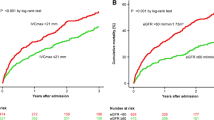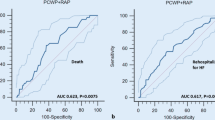Abstract
Renal dysfunction (RD) and venous congestion are related and common in heart failure (HF). Studies suggest that venous congestion may be the primary driver of RD in HF. In this study, we sought to investigate retrospectively the relationship between common measures of renal function with caval congestion and mortality among outpatients with HF and RD. We reviewed data from 103 HF outpatients (45 males, mean age 74 years, ejection fraction 41.8 ± 11.6 %) with estimated glomerular filtration rate (eGFR) of <60 ml/min in a single centre. During an ambulatory visit, all patients underwent blood test and ultrasonography of the inferior vena cava (IVC). Caval congestion was defined as IVC with both dilatation and impaired collapsibility. The best values of renal metrics in predicting caval congestion were determined with receiver-operating characteristic analysis. The BUN/Cr ratio is moderately correlated with IVC expiratory maximum diameter (r = 0.31, p < 0.0007). In a multiple logistic regression model, BUN/Cr >25.5 (adjusted OR 2.98, p 0.015) and eGFR ≤45.8 (adjusted OR 5.38, p 0.002) identify patients at risk for caval congestion; a BUN/Cr >23.7 was the best predictor of impaired collapsibility (adjusted OR 4.41, p 0.001). a BUN/Cr >25.5 (HR 2.19, 95 % CI 1.21–3.94, p < 0.001) and NYHA class 3 (HR 2.91, 95 % CI 1.60–5.31, p < 0.0005) were independent risk factors associated with all-cause death during a median follow-up of 31 months. In outpatients with HF and RD, a higher BUN/Cr and lower eGFR are reliable renal biomarkers for caval congestion. The BUN/Cr is associated with long-term mortality and may help to stratify HF severity.

Similar content being viewed by others

References
Cioffi G, Mortara A, Di Lenarda A, Oliva F, Lucci D, Senni M, Cacciatore G, Chinaglia A, Tarantini L, Metra M, Maggioni AP, Tavazzi L, on behalf of Italian Acute Heart Failure Survey (2013) Clinical features, and in-hospital and 1-year mortalities of patients with acute heart failure and severe renaldysfunction. Data from the Italian Registry IN-HF Outcome. Int J Cardiol pii: S0167-5273(13)01074-7
Ljungman S, Laragh JH, Cody RJ et al (1990) Role of the kidney in congestive heart failure: relationship of cardiac index to kidney function. Drug 39:10–24
Mullens W, Abrahams Z, Francis GS et al (2009) Importance of venous congestion for worsening of renal function in advanced decompensated heart failure. J Am Coll Cardiol 53:589–596
Sinkeler SJ, Damman K, van Veldhuisen DJ, Hillege H, Navis G (2012) A re-appraisal of volume status and renal function impairment in chronic heart failure: combined effects of pre-renal failure and venous congestion on renal function. Heart Fail Rev 17:263–270
Parrinello G, Torres D, Paterna S, Di Pasquale P, Licata G (2008) The pathophysiology of acute heart failure: the key role of fluid accumulation. Am Heart J 156:e19
Dupont M, Mullens W, Tang WH (2011) Impact of systemic venous congestion in heart failure. Curr Heart Fail Rep 8:233–241
Temporelli PL, Scapellato F, Giannuzzi P (2000) Non-invasive evaluation of the hemodynamic profile in patients with heart failure: estimation of right atrial pressure. Ital Heart J 1:1317S–1320S
Hollerbach S, Schultze K, Muscholl M, Schölmerich J (2001) Ultrasonography of the inferior vena cava (IVC) in the diagnosis and monitoring of therapy in patients with chronic congestive heart failure. Dtsch Med Wochenschr 126:129–133
Feissel M, Michard F, Faller JP et al (2004) The respiratory variation in inferior vena cava diameter as a guide to fluid therapy. Intensive Care Med 30:1834–1837
Blehar DJ, Dickman E, Gaspari R (2009) Identification of congestive heart failure via respiratory variation of inferior vena cava diameter. Am J Emerg Med 27:71–75
McMurray JJ, Adamopoulos S, Anker SD, Auricchio A, Böhm M, Dickstein K, Falk V, Filippatos G, Fonseca C, Gomez-Sanchez MA, Jaarsma T, Køber L, Lip GY, Maggioni AP, Parkhomenko A, Pieske BM, Popescu BA, Rønnevik PK, Rutten FH, Schwitter J, Seferovic P, Stepinska J, Trindade PT, Voors AA, Zannad F, Zeiher A, ESC Committee for Practice Guidelines (2012) ESC Guidelines for the diagnosis and treatment of acute and chronic heart failure 2012: the task force for the diagnosis and treatment of acute and chronic heart failure 2012 of the European Society of Cardiology. Developed in collaboration with the Heart Failure Association (HFA) of the ESC. Eur Heart J 33(14):1787–1847
Levey AS, Coresh J, Greene T, Stevens LA, Zhang YL, Hendriksen S, Kusek JW, Van Lente F, Chronic Kidney Disease Epidemiology Collaboration (2006) Using standardized serum creatinine values in the modification of diet in renal disease study equation for estimating glomerular filtration rate. Ann Intern Med 145:247–254
Lin HJ, Chao CL, Chien KL, Ho YL, Lee CM, Lin YH, Wu YW, Hsu RB, Chou NK, Wang SS, Chen CY, Chen MF (2009) Elevated blood urea nitrogen-to-creatinine ratio increased the risk of hospitalization and all-cause death in patients with chronic heart failure. Clin Res Cardiol 98:487–492
Brisco MA, Coca SG, Chen J, Owens AT, McCauley BD, Kimmel SE, Testani JM (2013) Blood urea nitrogen/creatinine ratio identifies a high-risk but potentially reversible form of renal dysfunction in patients with decompensated heart failure. Circ Heart Fail 6:233–239
Beigel R, Cercek B, Luo H, Siegel RJ (2013) Noninvasive evaluation of right atrial pressure. J Am Soc Echocardiogr. doi:10.1016/j.echo.2013.06.004
Kircher BJ, Himelman RB, Schiller NB (1990) Noninvasive estimation of right atrial pressure from the inspiratory collapse of the inferior vena cava. Am J Cardiol 66:493–496
Santoro A (2012) Heart failure and cardiorenal syndrome in the elderly. J Nephrol 25(Suppl 19):S67–S72
McCullough PA, Kellum JA, Haase M, Müller C, Damman K, Murray PT, Cruz D, House AA, Schmidt-Ott KM, Vescovo G, Bagshaw SM, Hoste EA, Briguori C, Braam B, Chawla LS, Costanzo MR, Tumlin JA, Herzog CA, Mehta RL, Rabb H, Shaw AD, Singbartl K, Ronco C (2013) Pathophysiology of the cardiorenal syndromes: executive summary from the eleventh consensus conference of the Acute dialysis quality initiative (ADQI). Contrib Nephrol 182:82–98
Damman K, Navis G, Smilde TD et al (2007) Decreased cardiac output, venous congestion and the association with renal impairment in patients with cardiac dysfunction. Eur J Heart Fail 9:872–878
Damman K, Voors AA, Hillege HL et al (2010) Congestion in chronic systolic heart failure is related to renal dysfunction and increased mortality. Eur J Heart Fail 12:974–982
Damman K, van Deursen VM, Navis G et al (2009) Increased central venous pressure is associated with impaired renal function and mortality in a broad spectrum of patients with cardiovascular disease. J Am Coll Cardiol 53:582–588
Parrinello G, Greene SJ, Torres D, Alderman M, Bonventre JV, Di Pasquale P, Gargani L, Nohria A, Fonarow GC, Vaduganathan M, Butler J, Paterna S, Stevenson LW, Gheorghiade M (2014) Water and sodium in heart failure: a spotlight on congestion. Heart Fail Rev 20:13–24
Testani JM, Damman K (2013) Venous congestion and renal function in heart failure. it’s complicated. Eur J Heart Fail 15:599–601
Kazory A (2010) Emergence of blood urea nitrogen as a biomarker of neurohormonal activation in heart failure. Am J Cardiol 106:694–700
Aronson D, Mittleman MA, Burger AJ (2004) Elevated blood urea nitrogen level as a predictor of mortality in patients admitted for decompensated heart failure. Am J Med 116:466–473
Martin PY, Schrier RW (1997) Sodium and water retention in heart failure: pathogenesis and treatment. Kidney Int Suppl 59(Suppl):S57–S61
Packer M (1992) The neurohormonal hypothesis: a theory to explain the mechanism of disease progression in heart failure. J Am Coll Cardiol 20:248–254
Parrinello G, Torres D, Paterna S (2011) Salt and water imbalance in chronic heart failure. Intern Emerg Med Suppl 1:29–36
Testani JM, Coca SG, Shannon RP, Kimmel SE, Cappola TP (2011) Influence of renal dysfunction phenotype on mortality in the setting of cardiac dysfunction: analysis of three randomized controlled trials. Eur J Heart Fail 13:1224–1230
Bankir LT, Trinh-Trang-Tan MM (2000) Renal urea transporters. Direct and indirect regulation by vasopressin. Exp Physiol 85S:243s–252s
Francis GS, Siegel RM, Goldsmith SR et al (1985) Acute vasoconstrictor response to intravenous furosemide in patients with chronic congestive heart failure. Activation of the neurohumoral axis. Ann Intern Med 103:1–6
Dossetor JB (1966) Creatininemia versus uremia. The relative significance of blood urea nitrogen and serum creatinine concentrations in azotemia. Ann Intern Med 65:1287–1299
Conflict of interest
The authors report no relationships that could be construed as a conflict of interest.
Statement of human and animal rights
All procedures performed in human participants were in accordance with the ethical standards of the institutional research committee and with the 1964 Helsinki declaration and its later amendments or comparable ethical standards. This article does not contain any studies with animals performed by any of the authors.
Informed consent
Informed consent was obtained from all individual participants included in the study.
Author information
Authors and Affiliations
Corresponding author
Rights and permissions
About this article
Cite this article
Parrinello, G., Torres, D., Testani, J.M. et al. Blood urea nitrogen to creatinine ratio is associated with congestion and mortality in heart failure patients with renal dysfunction. Intern Emerg Med 10, 965–972 (2015). https://doi.org/10.1007/s11739-015-1261-1
Received:
Accepted:
Published:
Issue Date:
DOI: https://doi.org/10.1007/s11739-015-1261-1



